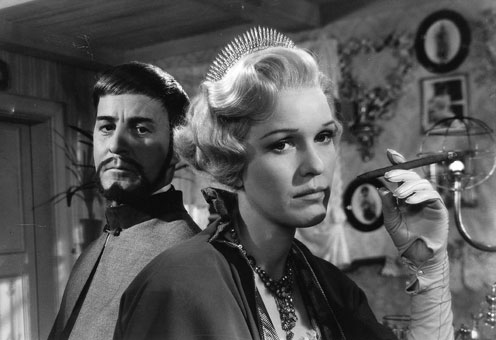

On top of that, the continuing trend to usurp orchestra pit space for additional seating has reached the point where the orchestrations have been reduced to what sounded like a keyboard, a violin and the occasional oboe. For theater-goers who remember the sumptuous original production (I was sitting next to one of those) it was quite a shock. For those who were not lucky enough to see the original production (me), it still looked skimpy and cheap – particularly for a hefty ticket price of $132 a seat.
The other big difference from the original production was a younger, more overtly sexual Desiree Armfeldt (Catherine Zeta-Jones). Director Trevor Nunn has said that this casting was inspired by the Ingmar Bergman film Smiles of a Summer Night on which the musical was based. It was still risky. Casting a younger woman as Desiree tends rob the role of much of its inherent pathos, and in the hands of a less charismatic actress it might not have worked.

Eva Dahlbeck (35) as Desiree in "Smiles of a Summer Night."
I’m still not convinced it works well, but Ms. Zeta-Jones’ big emotional performance, radiant beauty, and sheer star power carried the evening. Heard live, her singing is not as polished as it was in the soundtrack for Chicago, for which she won an Oscar, but she has a strong, handsome alto that easily encompasses the limited demands made by the score. Her famous eleven-o’clock number, “Send in the Clowns,” was richly textured and beautifully done.
As Desiree’s mother, Madame Armfeldt, Angela Lansbury was triumphant. What a wonderful performance! Exhibiting none of the halting memory lapses that marred last year’s charming, but oddly off-kilter, Madame Arcati in Blithe Spirit, the musical theater legend is on sure ground here in a part that plays to all of her strengths.
Alexander Hanson was also wonderful. He is a big, handsome man, and projected a calm, gentle sexuality that was exactly right for the conflicted Fredrick. He has a lovely singing voice, razor sharp timing and managed to quietly hold his own against Zeta-Jones’ and Lansbury – not an easy thing to do.
I wish I had liked the Carl-Magnus of Aaron Lazar more than I did. But for my taste he just isn’t a big enough man to project the larger than life swagger and pomposity needed to make this part work. And I’m sorry, Carl-Magnus needs to have a big, booming, operatic, baritone voice, not a stolid tenor.
Too often Charlotte becomes a part about self-deprecating one-liners. Erin Davie not only delivered every zinger right on target, but she also gave a deeply touching performance that let us see underneath the skin of this lonely, desperate woman. “Every Day a Little Death” was heartbreaking. Watch out for her: she’s a really great singing actress.
Hunter Ryan Herdlika was a sweet, charming Henrik, but Ramona Mallory needed to be slapped for her hysterical, over-the-top, annoying, shrill performance as Anne. But Katherine Leigh Doherty was lovely as young Fredrika Armfeldt.
Leigh Ann Larkin sang a strong, surprisingly moving “The Miller’s Son,” and was otherwise winning as Petra. Alone among the cast she did not attempt a British accent. Why?
The voices of the rest of the ensemble were thin, nasal and insubstantial. Combined with the spare orchestra, it contributed to the light weight, “on-the-cheap” feel of the show.
The choreography by Lynne Page was functional but uninspired. Other than his controversial choice about Desiree’s age, Nunn didn’t seem to have have much to say about the piece. Hartley T A Kemp needs to go back to lighting school or wherever it is lighting designers are supposed to learn how to design lights, because 75% of the show was played in the dark.

























Comments